Operations and Project Management: A Case Study of Dyson Limited
VerifiedAdded on 2023/06/11
|17
|5985
|411
AI Summary
This report discusses the operational and project management principles applied by Dyson Limited, a multinational technology company. It analyzes the extent to which organizational operations management meets the requirements of the company and discusses continuous improvement as a philosophy. The report also describes Lean principles and their application in the company. The report includes a case study of Dyson Limited and analyzes each stage of the product life cycle.
Contribute Materials
Your contribution can guide someone’s learning journey. Share your
documents today.
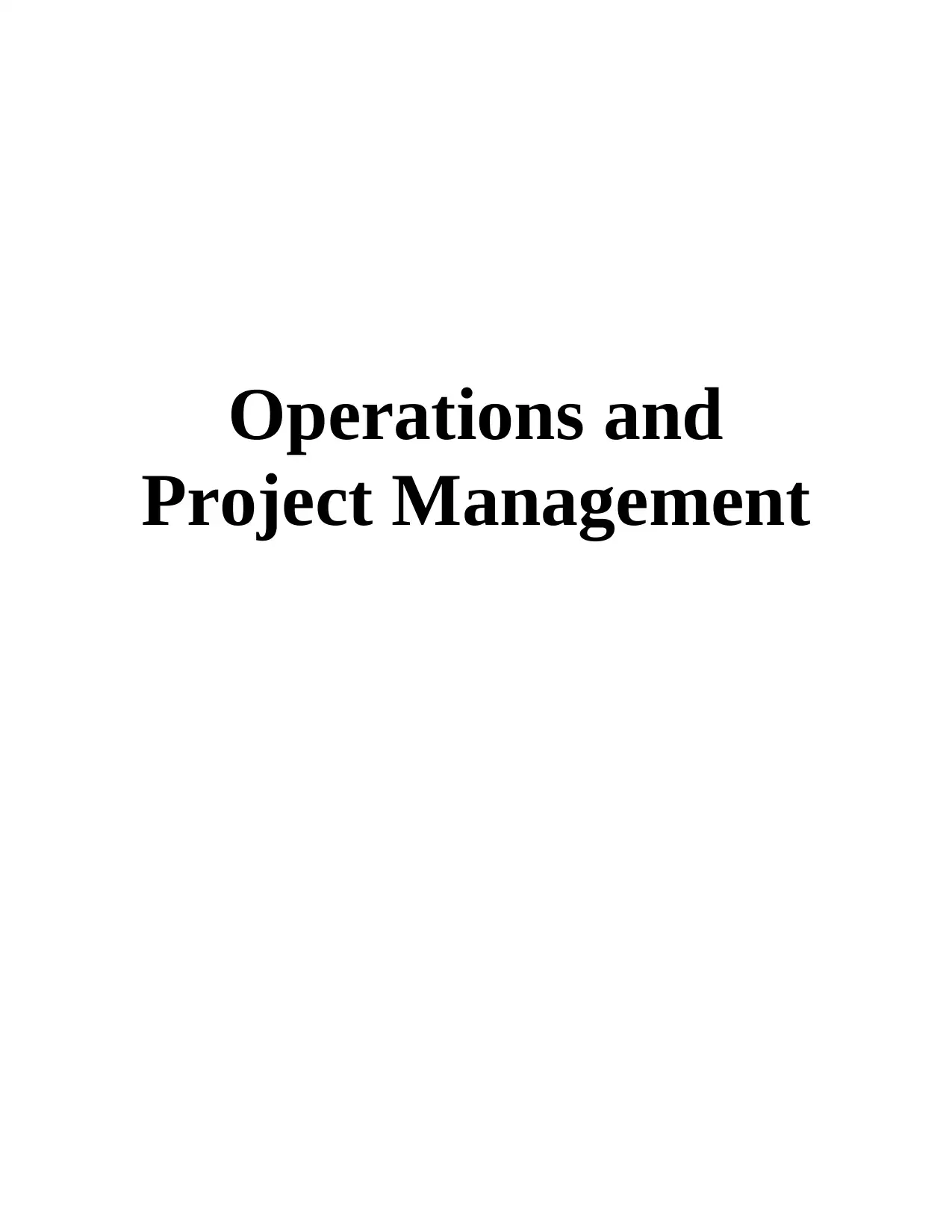
Operations and
Project Management
Project Management
Secure Best Marks with AI Grader
Need help grading? Try our AI Grader for instant feedback on your assignments.
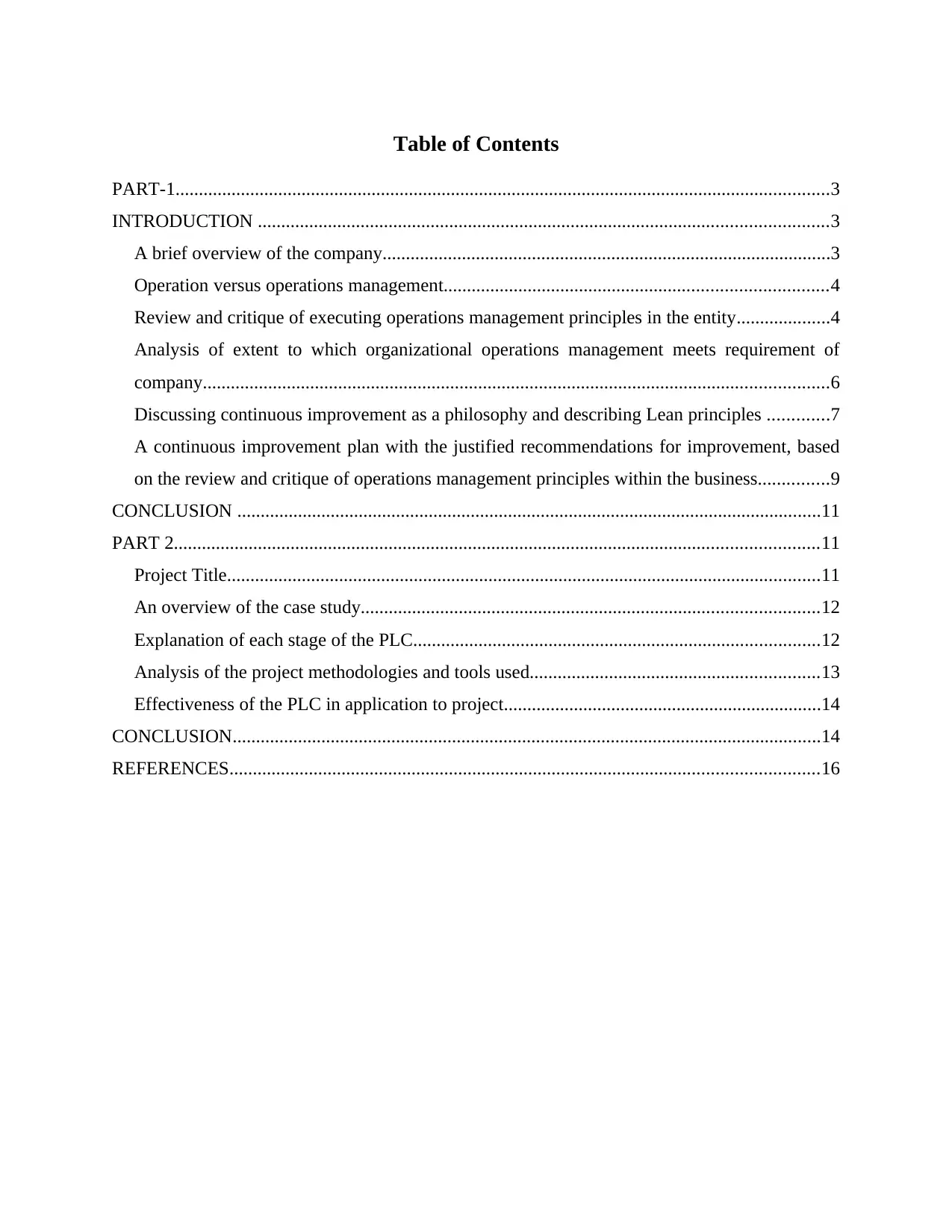
Table of Contents
PART-1............................................................................................................................................3
INTRODUCTION ..........................................................................................................................3
A brief overview of the company................................................................................................3
Operation versus operations management..................................................................................4
Review and critique of executing operations management principles in the entity....................4
Analysis of extent to which organizational operations management meets requirement of
company......................................................................................................................................6
Discussing continuous improvement as a philosophy and describing Lean principles .............7
A continuous improvement plan with the justified recommendations for improvement, based
on the review and critique of operations management principles within the business...............9
CONCLUSION .............................................................................................................................11
PART 2..........................................................................................................................................11
Project Title...............................................................................................................................11
An overview of the case study..................................................................................................12
Explanation of each stage of the PLC.......................................................................................12
Analysis of the project methodologies and tools used..............................................................13
Effectiveness of the PLC in application to project....................................................................14
CONCLUSION..............................................................................................................................14
REFERENCES..............................................................................................................................16
PART-1............................................................................................................................................3
INTRODUCTION ..........................................................................................................................3
A brief overview of the company................................................................................................3
Operation versus operations management..................................................................................4
Review and critique of executing operations management principles in the entity....................4
Analysis of extent to which organizational operations management meets requirement of
company......................................................................................................................................6
Discussing continuous improvement as a philosophy and describing Lean principles .............7
A continuous improvement plan with the justified recommendations for improvement, based
on the review and critique of operations management principles within the business...............9
CONCLUSION .............................................................................................................................11
PART 2..........................................................................................................................................11
Project Title...............................................................................................................................11
An overview of the case study..................................................................................................12
Explanation of each stage of the PLC.......................................................................................12
Analysis of the project methodologies and tools used..............................................................13
Effectiveness of the PLC in application to project....................................................................14
CONCLUSION..............................................................................................................................14
REFERENCES..............................................................................................................................16

PART-1
INTRODUCTION
Operational management may be defined as that functional area of business who is
responsible for handling the processes which includes the creation of goods and services. On the
other hand, the project management may be defined as the process of directing the efforts of
team members towards the goals and objective of the firm(Ho and Chuah, 2019). Operational
management is basically an administration part that comprises of different types of aspects such
as capability, computation, consumables, equipment, labour and many more which assist in
transforming the raw material into the finish goods. The fist and the foremost objective of the
operational team of the company is to boost up the revenue by generating the products in large
quantity. The following report is based on the Dyson Limited which is well-known designer and
producer of home appliances like bladeless fans, air purifiers, hair dryers and many more. The
chosen company is private organisation which was founded in 1991 by James Dyson in England
but in 2019 the respective company permanently shifted to Singapore. The Headquarter of the
company is situated in St James Power Station, Harbourfront, Singapore. The following report is
going to cover the effectiveness of operations management principles along with the concept of
continuous improvement in context to the chosen organisation. This report also focus on the each
step of the product life cycle and produce a necessary support document. In the end, a critical
analysis has been done in relation to the application of PLC by employing relevant theories and
models.
A brief overview of the company
Dyson limited is a multinational technology company which was established in 1991 by
James Dyson. The respective organization first established at Malmesbury, England and
designed the household product such as Vacuum cleaners, air purifiers, hand dryers, hair dryers,
lights and many more. The motive of the company is to motivate the entrepreneurs of new
generation and regularly find the new ways to dealing with the problems. The company provide
their services all across the globe and give provide employment to around 13000 employees
internationally. Focus has been paid by the management of the firm on solving the problems and
complexities which are overlook by the other firm by utilizing the technologies. In 2019, it was
INTRODUCTION
Operational management may be defined as that functional area of business who is
responsible for handling the processes which includes the creation of goods and services. On the
other hand, the project management may be defined as the process of directing the efforts of
team members towards the goals and objective of the firm(Ho and Chuah, 2019). Operational
management is basically an administration part that comprises of different types of aspects such
as capability, computation, consumables, equipment, labour and many more which assist in
transforming the raw material into the finish goods. The fist and the foremost objective of the
operational team of the company is to boost up the revenue by generating the products in large
quantity. The following report is based on the Dyson Limited which is well-known designer and
producer of home appliances like bladeless fans, air purifiers, hair dryers and many more. The
chosen company is private organisation which was founded in 1991 by James Dyson in England
but in 2019 the respective company permanently shifted to Singapore. The Headquarter of the
company is situated in St James Power Station, Harbourfront, Singapore. The following report is
going to cover the effectiveness of operations management principles along with the concept of
continuous improvement in context to the chosen organisation. This report also focus on the each
step of the product life cycle and produce a necessary support document. In the end, a critical
analysis has been done in relation to the application of PLC by employing relevant theories and
models.
A brief overview of the company
Dyson limited is a multinational technology company which was established in 1991 by
James Dyson. The respective organization first established at Malmesbury, England and
designed the household product such as Vacuum cleaners, air purifiers, hand dryers, hair dryers,
lights and many more. The motive of the company is to motivate the entrepreneurs of new
generation and regularly find the new ways to dealing with the problems. The company provide
their services all across the globe and give provide employment to around 13000 employees
internationally. Focus has been paid by the management of the firm on solving the problems and
complexities which are overlook by the other firm by utilizing the technologies. In 2019, it was
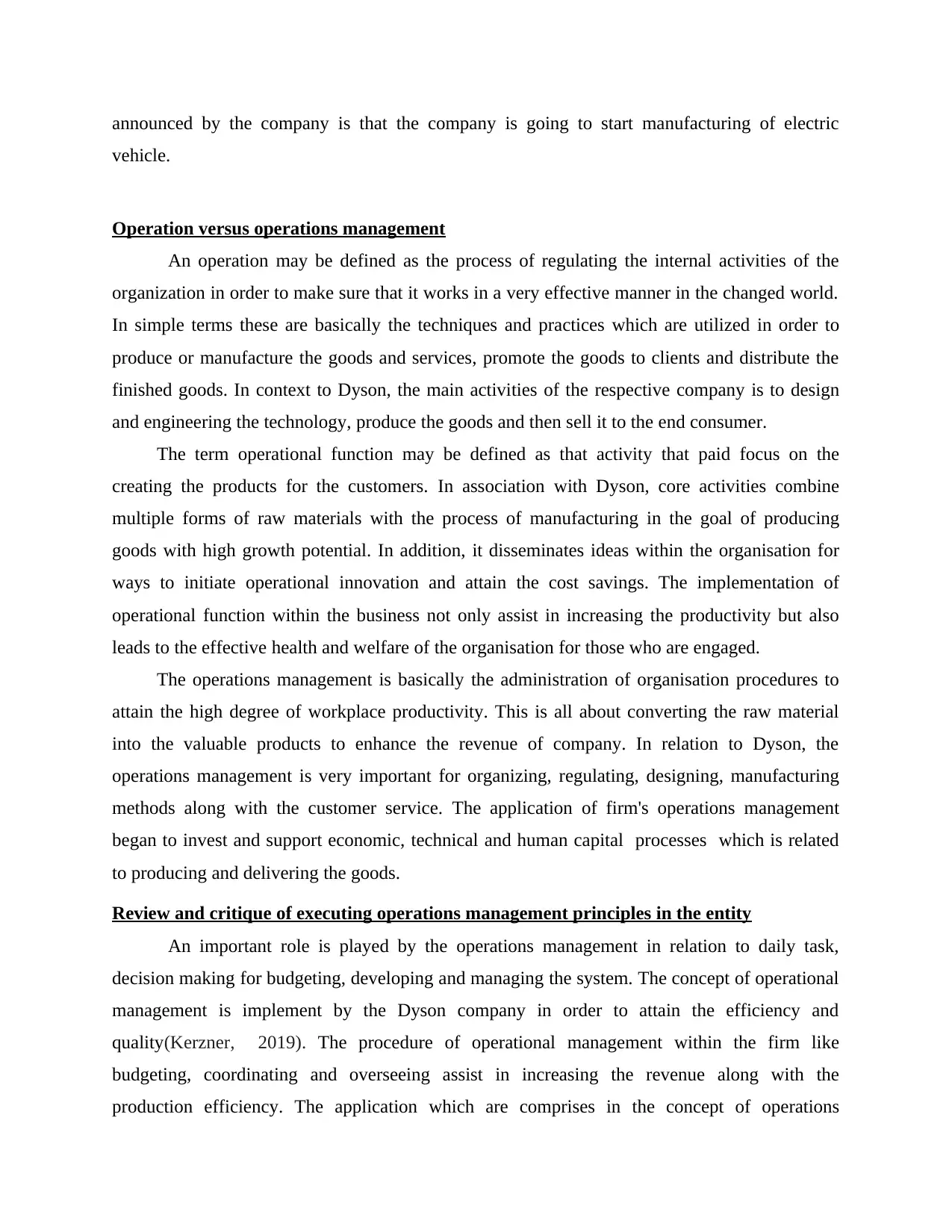
announced by the company is that the company is going to start manufacturing of electric
vehicle.
Operation versus operations management
An operation may be defined as the process of regulating the internal activities of the
organization in order to make sure that it works in a very effective manner in the changed world.
In simple terms these are basically the techniques and practices which are utilized in order to
produce or manufacture the goods and services, promote the goods to clients and distribute the
finished goods. In context to Dyson, the main activities of the respective company is to design
and engineering the technology, produce the goods and then sell it to the end consumer.
The term operational function may be defined as that activity that paid focus on the
creating the products for the customers. In association with Dyson, core activities combine
multiple forms of raw materials with the process of manufacturing in the goal of producing
goods with high growth potential. In addition, it disseminates ideas within the organisation for
ways to initiate operational innovation and attain the cost savings. The implementation of
operational function within the business not only assist in increasing the productivity but also
leads to the effective health and welfare of the organisation for those who are engaged.
The operations management is basically the administration of organisation procedures to
attain the high degree of workplace productivity. This is all about converting the raw material
into the valuable products to enhance the revenue of company. In relation to Dyson, the
operations management is very important for organizing, regulating, designing, manufacturing
methods along with the customer service. The application of firm's operations management
began to invest and support economic, technical and human capital processes which is related
to producing and delivering the goods.
Review and critique of executing operations management principles in the entity
An important role is played by the operations management in relation to daily task,
decision making for budgeting, developing and managing the system. The concept of operational
management is implement by the Dyson company in order to attain the efficiency and
quality(Kerzner, 2019). The procedure of operational management within the firm like
budgeting, coordinating and overseeing assist in increasing the revenue along with the
production efficiency. The application which are comprises in the concept of operations
vehicle.
Operation versus operations management
An operation may be defined as the process of regulating the internal activities of the
organization in order to make sure that it works in a very effective manner in the changed world.
In simple terms these are basically the techniques and practices which are utilized in order to
produce or manufacture the goods and services, promote the goods to clients and distribute the
finished goods. In context to Dyson, the main activities of the respective company is to design
and engineering the technology, produce the goods and then sell it to the end consumer.
The term operational function may be defined as that activity that paid focus on the
creating the products for the customers. In association with Dyson, core activities combine
multiple forms of raw materials with the process of manufacturing in the goal of producing
goods with high growth potential. In addition, it disseminates ideas within the organisation for
ways to initiate operational innovation and attain the cost savings. The implementation of
operational function within the business not only assist in increasing the productivity but also
leads to the effective health and welfare of the organisation for those who are engaged.
The operations management is basically the administration of organisation procedures to
attain the high degree of workplace productivity. This is all about converting the raw material
into the valuable products to enhance the revenue of company. In relation to Dyson, the
operations management is very important for organizing, regulating, designing, manufacturing
methods along with the customer service. The application of firm's operations management
began to invest and support economic, technical and human capital processes which is related
to producing and delivering the goods.
Review and critique of executing operations management principles in the entity
An important role is played by the operations management in relation to daily task,
decision making for budgeting, developing and managing the system. The concept of operational
management is implement by the Dyson company in order to attain the efficiency and
quality(Kerzner, 2019). The procedure of operational management within the firm like
budgeting, coordinating and overseeing assist in increasing the revenue along with the
production efficiency. The application which are comprises in the concept of operations
Secure Best Marks with AI Grader
Need help grading? Try our AI Grader for instant feedback on your assignments.
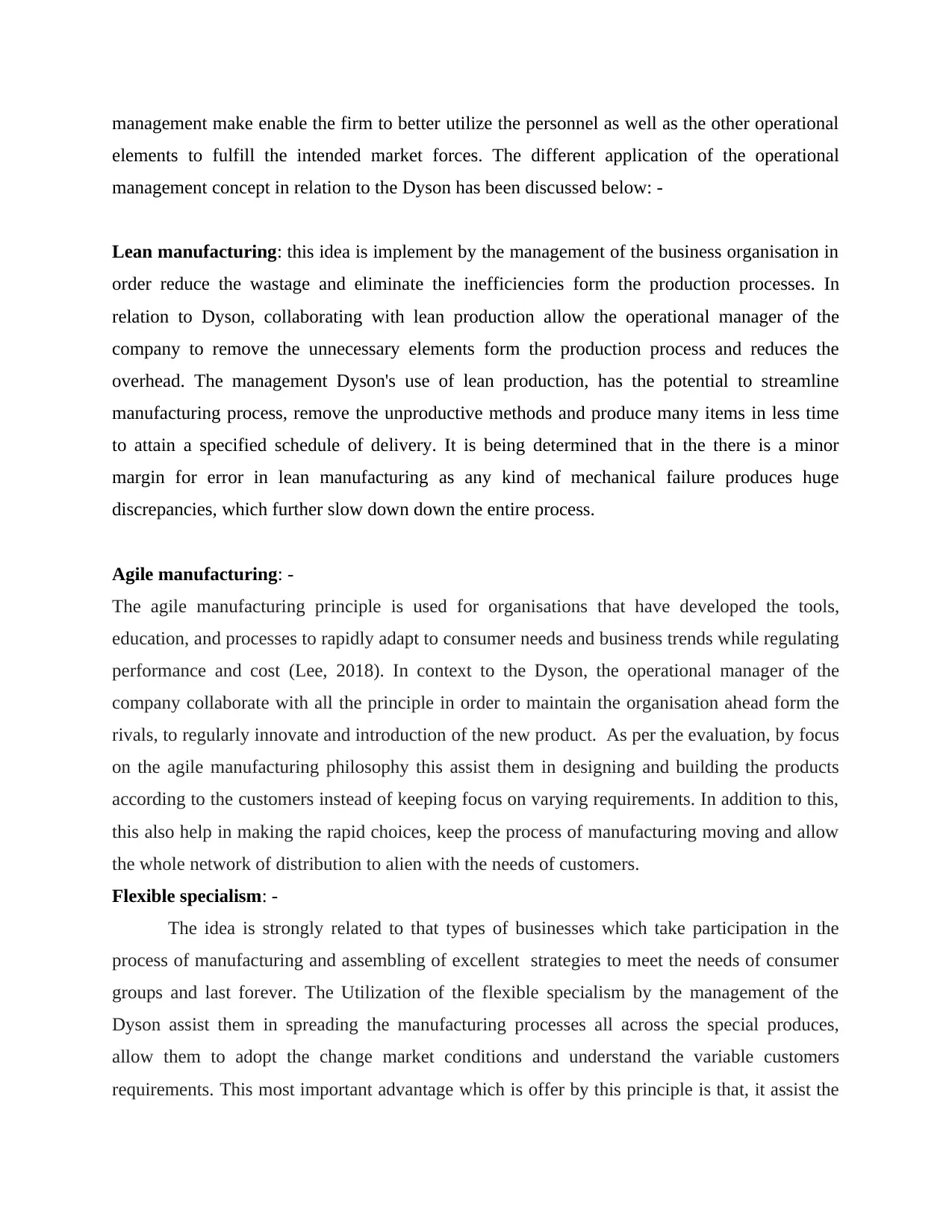
management make enable the firm to better utilize the personnel as well as the other operational
elements to fulfill the intended market forces. The different application of the operational
management concept in relation to the Dyson has been discussed below: -
Lean manufacturing: this idea is implement by the management of the business organisation in
order reduce the wastage and eliminate the inefficiencies form the production processes. In
relation to Dyson, collaborating with lean production allow the operational manager of the
company to remove the unnecessary elements form the production process and reduces the
overhead. The management Dyson's use of lean production, has the potential to streamline
manufacturing process, remove the unproductive methods and produce many items in less time
to attain a specified schedule of delivery. It is being determined that in the there is a minor
margin for error in lean manufacturing as any kind of mechanical failure produces huge
discrepancies, which further slow down down the entire process.
Agile manufacturing: -
The agile manufacturing principle is used for organisations that have developed the tools,
education, and processes to rapidly adapt to consumer needs and business trends while regulating
performance and cost (Lee, 2018). In context to the Dyson, the operational manager of the
company collaborate with all the principle in order to maintain the organisation ahead form the
rivals, to regularly innovate and introduction of the new product. As per the evaluation, by focus
on the agile manufacturing philosophy this assist them in designing and building the products
according to the customers instead of keeping focus on varying requirements. In addition to this,
this also help in making the rapid choices, keep the process of manufacturing moving and allow
the whole network of distribution to alien with the needs of customers.
Flexible specialism: -
The idea is strongly related to that types of businesses which take participation in the
process of manufacturing and assembling of excellent strategies to meet the needs of consumer
groups and last forever. The Utilization of the flexible specialism by the management of the
Dyson assist them in spreading the manufacturing processes all across the special produces,
allow them to adopt the change market conditions and understand the variable customers
requirements. This most important advantage which is offer by this principle is that, it assist the
elements to fulfill the intended market forces. The different application of the operational
management concept in relation to the Dyson has been discussed below: -
Lean manufacturing: this idea is implement by the management of the business organisation in
order reduce the wastage and eliminate the inefficiencies form the production processes. In
relation to Dyson, collaborating with lean production allow the operational manager of the
company to remove the unnecessary elements form the production process and reduces the
overhead. The management Dyson's use of lean production, has the potential to streamline
manufacturing process, remove the unproductive methods and produce many items in less time
to attain a specified schedule of delivery. It is being determined that in the there is a minor
margin for error in lean manufacturing as any kind of mechanical failure produces huge
discrepancies, which further slow down down the entire process.
Agile manufacturing: -
The agile manufacturing principle is used for organisations that have developed the tools,
education, and processes to rapidly adapt to consumer needs and business trends while regulating
performance and cost (Lee, 2018). In context to the Dyson, the operational manager of the
company collaborate with all the principle in order to maintain the organisation ahead form the
rivals, to regularly innovate and introduction of the new product. As per the evaluation, by focus
on the agile manufacturing philosophy this assist them in designing and building the products
according to the customers instead of keeping focus on varying requirements. In addition to this,
this also help in making the rapid choices, keep the process of manufacturing moving and allow
the whole network of distribution to alien with the needs of customers.
Flexible specialism: -
The idea is strongly related to that types of businesses which take participation in the
process of manufacturing and assembling of excellent strategies to meet the needs of consumer
groups and last forever. The Utilization of the flexible specialism by the management of the
Dyson assist them in spreading the manufacturing processes all across the special produces,
allow them to adopt the change market conditions and understand the variable customers
requirements. This most important advantage which is offer by this principle is that, it assist the
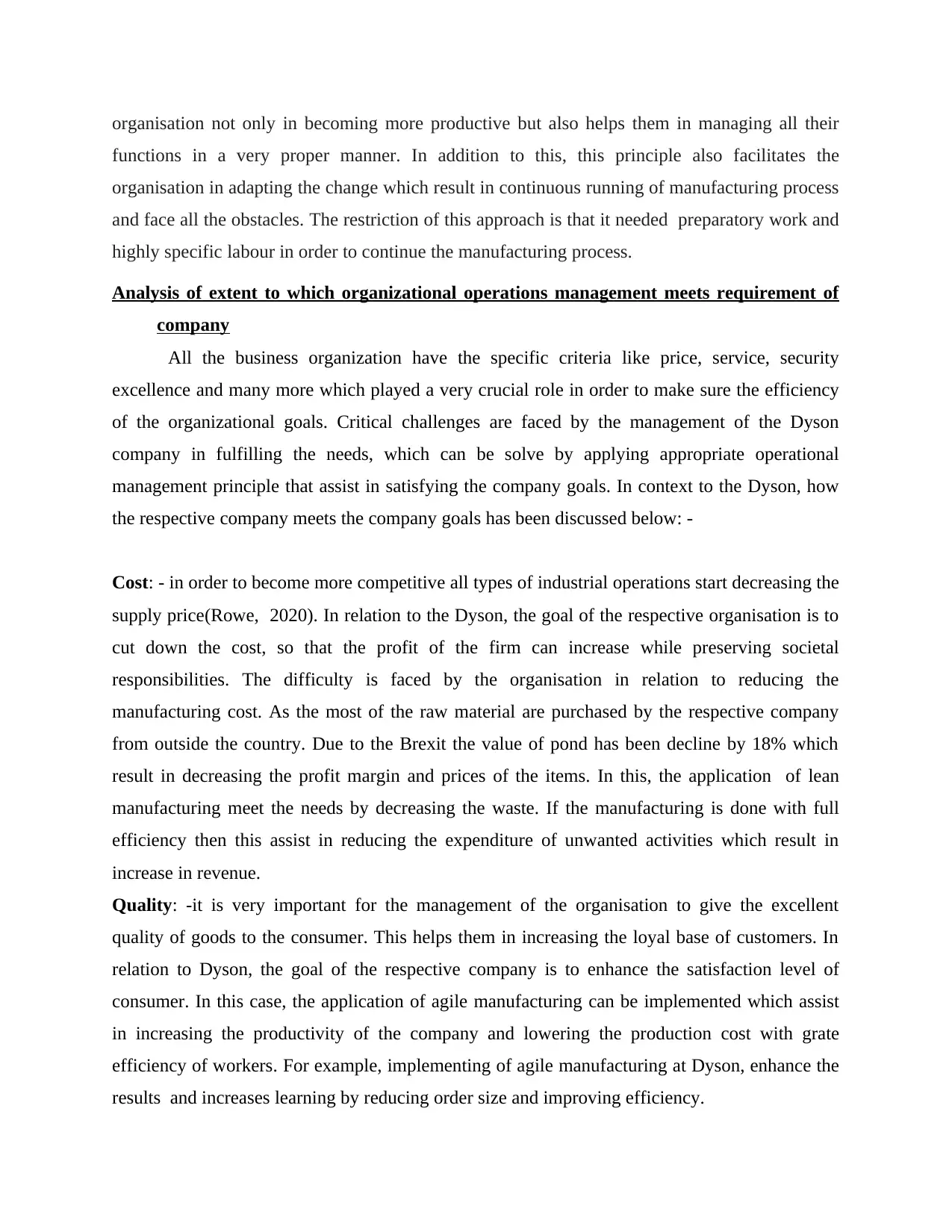
organisation not only in becoming more productive but also helps them in managing all their
functions in a very proper manner. In addition to this, this principle also facilitates the
organisation in adapting the change which result in continuous running of manufacturing process
and face all the obstacles. The restriction of this approach is that it needed preparatory work and
highly specific labour in order to continue the manufacturing process.
Analysis of extent to which organizational operations management meets requirement of
company
All the business organization have the specific criteria like price, service, security
excellence and many more which played a very crucial role in order to make sure the efficiency
of the organizational goals. Critical challenges are faced by the management of the Dyson
company in fulfilling the needs, which can be solve by applying appropriate operational
management principle that assist in satisfying the company goals. In context to the Dyson, how
the respective company meets the company goals has been discussed below: -
Cost: - in order to become more competitive all types of industrial operations start decreasing the
supply price(Rowe, 2020). In relation to the Dyson, the goal of the respective organisation is to
cut down the cost, so that the profit of the firm can increase while preserving societal
responsibilities. The difficulty is faced by the organisation in relation to reducing the
manufacturing cost. As the most of the raw material are purchased by the respective company
from outside the country. Due to the Brexit the value of pond has been decline by 18% which
result in decreasing the profit margin and prices of the items. In this, the application of lean
manufacturing meet the needs by decreasing the waste. If the manufacturing is done with full
efficiency then this assist in reducing the expenditure of unwanted activities which result in
increase in revenue.
Quality: -it is very important for the management of the organisation to give the excellent
quality of goods to the consumer. This helps them in increasing the loyal base of customers. In
relation to Dyson, the goal of the respective company is to enhance the satisfaction level of
consumer. In this case, the application of agile manufacturing can be implemented which assist
in increasing the productivity of the company and lowering the production cost with grate
efficiency of workers. For example, implementing of agile manufacturing at Dyson, enhance the
results and increases learning by reducing order size and improving efficiency.
functions in a very proper manner. In addition to this, this principle also facilitates the
organisation in adapting the change which result in continuous running of manufacturing process
and face all the obstacles. The restriction of this approach is that it needed preparatory work and
highly specific labour in order to continue the manufacturing process.
Analysis of extent to which organizational operations management meets requirement of
company
All the business organization have the specific criteria like price, service, security
excellence and many more which played a very crucial role in order to make sure the efficiency
of the organizational goals. Critical challenges are faced by the management of the Dyson
company in fulfilling the needs, which can be solve by applying appropriate operational
management principle that assist in satisfying the company goals. In context to the Dyson, how
the respective company meets the company goals has been discussed below: -
Cost: - in order to become more competitive all types of industrial operations start decreasing the
supply price(Rowe, 2020). In relation to the Dyson, the goal of the respective organisation is to
cut down the cost, so that the profit of the firm can increase while preserving societal
responsibilities. The difficulty is faced by the organisation in relation to reducing the
manufacturing cost. As the most of the raw material are purchased by the respective company
from outside the country. Due to the Brexit the value of pond has been decline by 18% which
result in decreasing the profit margin and prices of the items. In this, the application of lean
manufacturing meet the needs by decreasing the waste. If the manufacturing is done with full
efficiency then this assist in reducing the expenditure of unwanted activities which result in
increase in revenue.
Quality: -it is very important for the management of the organisation to give the excellent
quality of goods to the consumer. This helps them in increasing the loyal base of customers. In
relation to Dyson, the goal of the respective company is to enhance the satisfaction level of
consumer. In this case, the application of agile manufacturing can be implemented which assist
in increasing the productivity of the company and lowering the production cost with grate
efficiency of workers. For example, implementing of agile manufacturing at Dyson, enhance the
results and increases learning by reducing order size and improving efficiency.
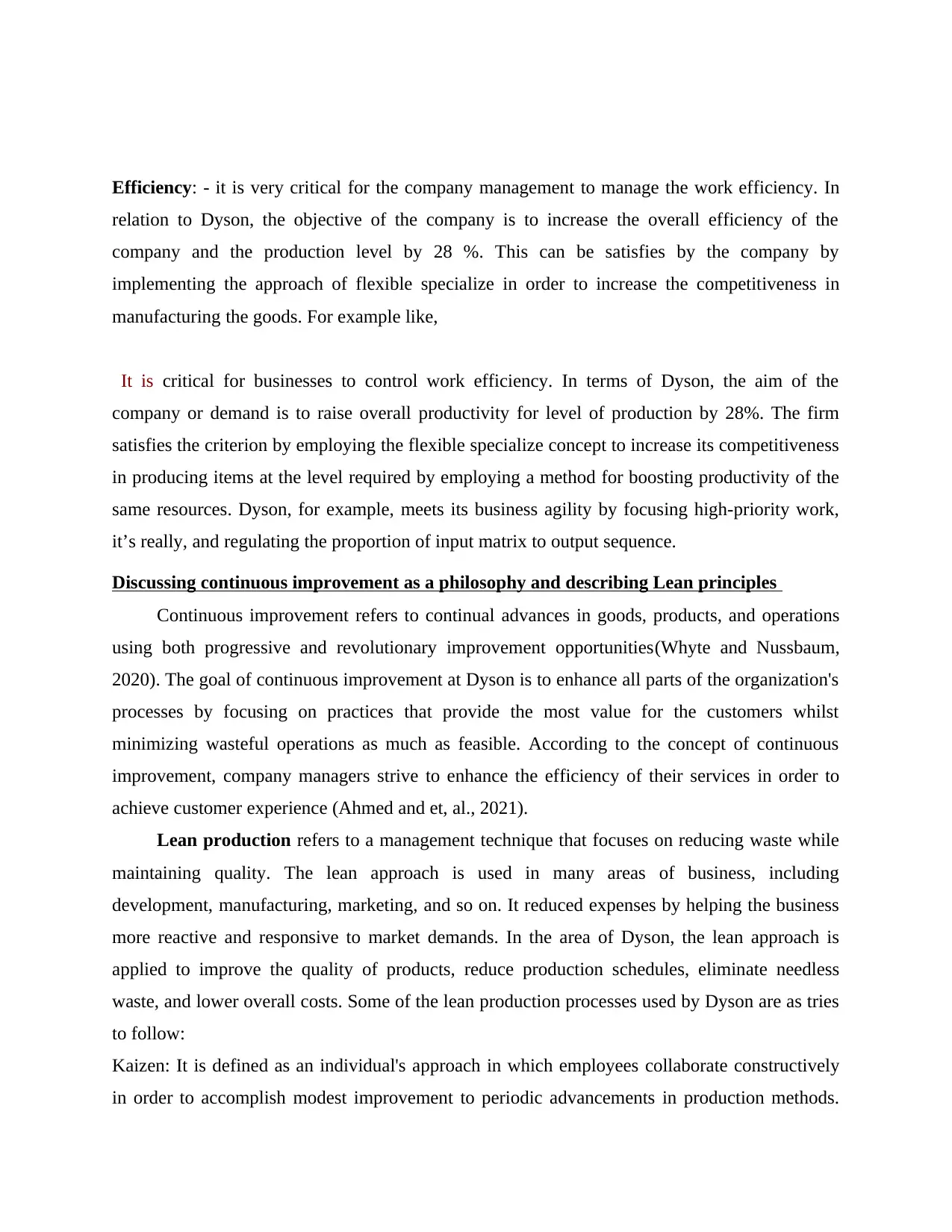
Efficiency: - it is very critical for the company management to manage the work efficiency. In
relation to Dyson, the objective of the company is to increase the overall efficiency of the
company and the production level by 28 %. This can be satisfies by the company by
implementing the approach of flexible specialize in order to increase the competitiveness in
manufacturing the goods. For example like,
It is critical for businesses to control work efficiency. In terms of Dyson, the aim of the
company or demand is to raise overall productivity for level of production by 28%. The firm
satisfies the criterion by employing the flexible specialize concept to increase its competitiveness
in producing items at the level required by employing a method for boosting productivity of the
same resources. Dyson, for example, meets its business agility by focusing high-priority work,
it’s really, and regulating the proportion of input matrix to output sequence.
Discussing continuous improvement as a philosophy and describing Lean principles
Continuous improvement refers to continual advances in goods, products, and operations
using both progressive and revolutionary improvement opportunities(Whyte and Nussbaum,
2020). The goal of continuous improvement at Dyson is to enhance all parts of the organization's
processes by focusing on practices that provide the most value for the customers whilst
minimizing wasteful operations as much as feasible. According to the concept of continuous
improvement, company managers strive to enhance the efficiency of their services in order to
achieve customer experience (Ahmed and et, al., 2021).
Lean production refers to a management technique that focuses on reducing waste while
maintaining quality. The lean approach is used in many areas of business, including
development, manufacturing, marketing, and so on. It reduced expenses by helping the business
more reactive and responsive to market demands. In the area of Dyson, the lean approach is
applied to improve the quality of products, reduce production schedules, eliminate needless
waste, and lower overall costs. Some of the lean production processes used by Dyson are as tries
to follow:
Kaizen: It is defined as an individual's approach in which employees collaborate constructively
in order to accomplish modest improvement to periodic advancements in production methods.
relation to Dyson, the objective of the company is to increase the overall efficiency of the
company and the production level by 28 %. This can be satisfies by the company by
implementing the approach of flexible specialize in order to increase the competitiveness in
manufacturing the goods. For example like,
It is critical for businesses to control work efficiency. In terms of Dyson, the aim of the
company or demand is to raise overall productivity for level of production by 28%. The firm
satisfies the criterion by employing the flexible specialize concept to increase its competitiveness
in producing items at the level required by employing a method for boosting productivity of the
same resources. Dyson, for example, meets its business agility by focusing high-priority work,
it’s really, and regulating the proportion of input matrix to output sequence.
Discussing continuous improvement as a philosophy and describing Lean principles
Continuous improvement refers to continual advances in goods, products, and operations
using both progressive and revolutionary improvement opportunities(Whyte and Nussbaum,
2020). The goal of continuous improvement at Dyson is to enhance all parts of the organization's
processes by focusing on practices that provide the most value for the customers whilst
minimizing wasteful operations as much as feasible. According to the concept of continuous
improvement, company managers strive to enhance the efficiency of their services in order to
achieve customer experience (Ahmed and et, al., 2021).
Lean production refers to a management technique that focuses on reducing waste while
maintaining quality. The lean approach is used in many areas of business, including
development, manufacturing, marketing, and so on. It reduced expenses by helping the business
more reactive and responsive to market demands. In the area of Dyson, the lean approach is
applied to improve the quality of products, reduce production schedules, eliminate needless
waste, and lower overall costs. Some of the lean production processes used by Dyson are as tries
to follow:
Kaizen: It is defined as an individual's approach in which employees collaborate constructively
in order to accomplish modest improvement to periodic advancements in production methods.
Paraphrase This Document
Need a fresh take? Get an instant paraphrase of this document with our AI Paraphraser
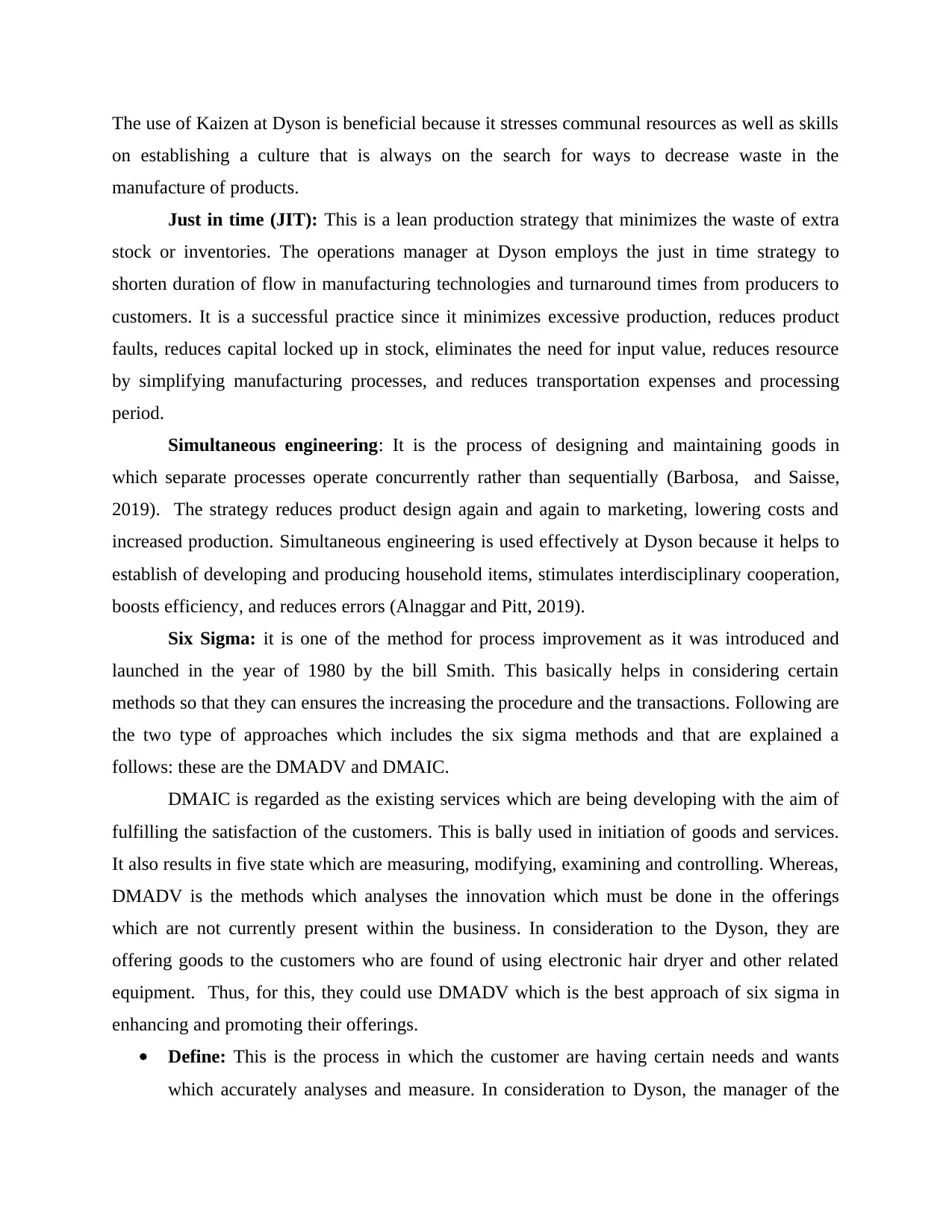
The use of Kaizen at Dyson is beneficial because it stresses communal resources as well as skills
on establishing a culture that is always on the search for ways to decrease waste in the
manufacture of products.
Just in time (JIT): This is a lean production strategy that minimizes the waste of extra
stock or inventories. The operations manager at Dyson employs the just in time strategy to
shorten duration of flow in manufacturing technologies and turnaround times from producers to
customers. It is a successful practice since it minimizes excessive production, reduces product
faults, reduces capital locked up in stock, eliminates the need for input value, reduces resource
by simplifying manufacturing processes, and reduces transportation expenses and processing
period.
Simultaneous engineering: It is the process of designing and maintaining goods in
which separate processes operate concurrently rather than sequentially (Barbosa, and Saisse,
2019). The strategy reduces product design again and again to marketing, lowering costs and
increased production. Simultaneous engineering is used effectively at Dyson because it helps to
establish of developing and producing household items, stimulates interdisciplinary cooperation,
boosts efficiency, and reduces errors (Alnaggar and Pitt, 2019).
Six Sigma: it is one of the method for process improvement as it was introduced and
launched in the year of 1980 by the bill Smith. This basically helps in considering certain
methods so that they can ensures the increasing the procedure and the transactions. Following are
the two type of approaches which includes the six sigma methods and that are explained a
follows: these are the DMADV and DMAIC.
DMAIC is regarded as the existing services which are being developing with the aim of
fulfilling the satisfaction of the customers. This is bally used in initiation of goods and services.
It also results in five state which are measuring, modifying, examining and controlling. Whereas,
DMADV is the methods which analyses the innovation which must be done in the offerings
which are not currently present within the business. In consideration to the Dyson, they are
offering goods to the customers who are found of using electronic hair dryer and other related
equipment. Thus, for this, they could use DMADV which is the best approach of six sigma in
enhancing and promoting their offerings.
Define: This is the process in which the customer are having certain needs and wants
which accurately analyses and measure. In consideration to Dyson, the manager of the
on establishing a culture that is always on the search for ways to decrease waste in the
manufacture of products.
Just in time (JIT): This is a lean production strategy that minimizes the waste of extra
stock or inventories. The operations manager at Dyson employs the just in time strategy to
shorten duration of flow in manufacturing technologies and turnaround times from producers to
customers. It is a successful practice since it minimizes excessive production, reduces product
faults, reduces capital locked up in stock, eliminates the need for input value, reduces resource
by simplifying manufacturing processes, and reduces transportation expenses and processing
period.
Simultaneous engineering: It is the process of designing and maintaining goods in
which separate processes operate concurrently rather than sequentially (Barbosa, and Saisse,
2019). The strategy reduces product design again and again to marketing, lowering costs and
increased production. Simultaneous engineering is used effectively at Dyson because it helps to
establish of developing and producing household items, stimulates interdisciplinary cooperation,
boosts efficiency, and reduces errors (Alnaggar and Pitt, 2019).
Six Sigma: it is one of the method for process improvement as it was introduced and
launched in the year of 1980 by the bill Smith. This basically helps in considering certain
methods so that they can ensures the increasing the procedure and the transactions. Following are
the two type of approaches which includes the six sigma methods and that are explained a
follows: these are the DMADV and DMAIC.
DMAIC is regarded as the existing services which are being developing with the aim of
fulfilling the satisfaction of the customers. This is bally used in initiation of goods and services.
It also results in five state which are measuring, modifying, examining and controlling. Whereas,
DMADV is the methods which analyses the innovation which must be done in the offerings
which are not currently present within the business. In consideration to the Dyson, they are
offering goods to the customers who are found of using electronic hair dryer and other related
equipment. Thus, for this, they could use DMADV which is the best approach of six sigma in
enhancing and promoting their offerings.
Define: This is the process in which the customer are having certain needs and wants
which accurately analyses and measure. In consideration to Dyson, the manager of the
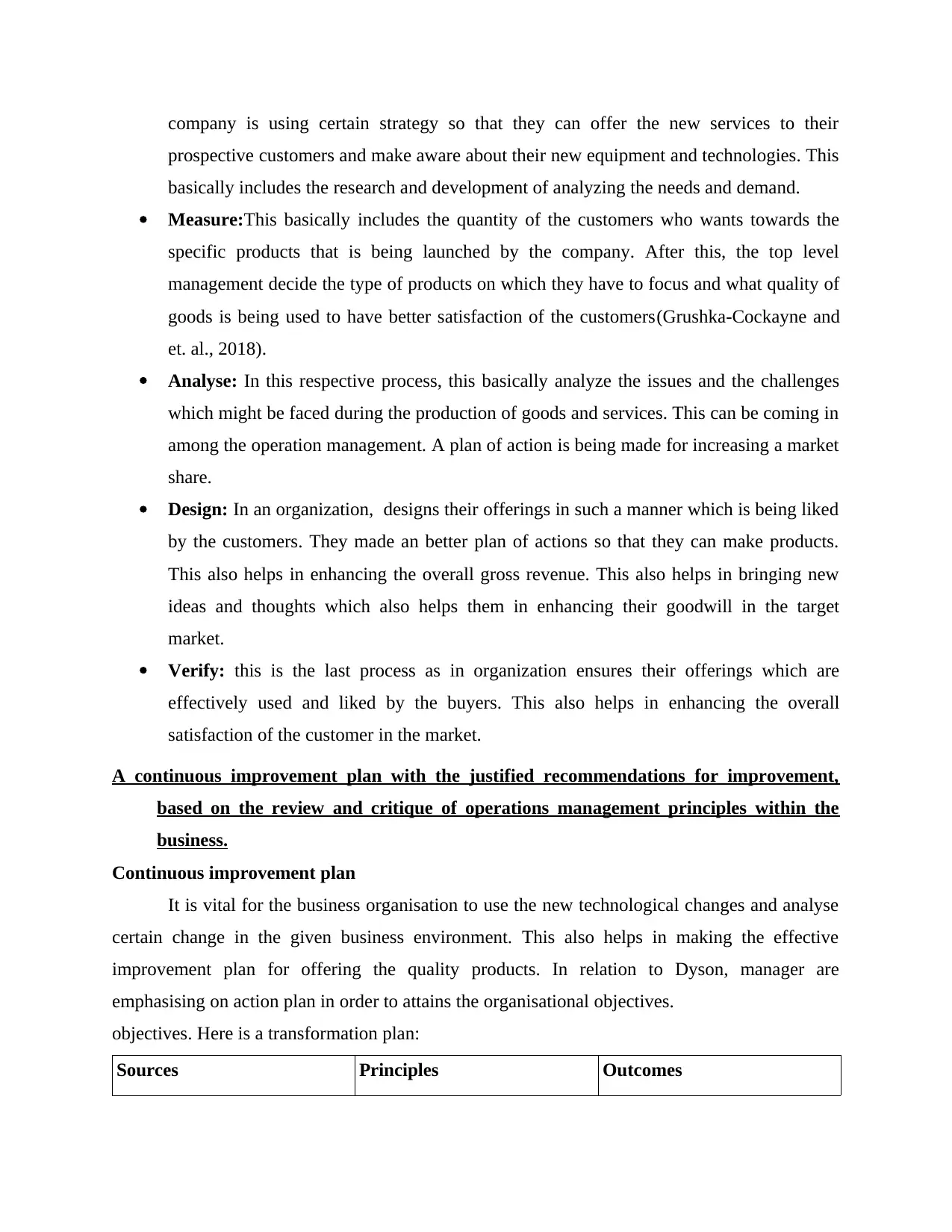
company is using certain strategy so that they can offer the new services to their
prospective customers and make aware about their new equipment and technologies. This
basically includes the research and development of analyzing the needs and demand.
Measure:This basically includes the quantity of the customers who wants towards the
specific products that is being launched by the company. After this, the top level
management decide the type of products on which they have to focus and what quality of
goods is being used to have better satisfaction of the customers(Grushka-Cockayne and
et. al., 2018).
Analyse: In this respective process, this basically analyze the issues and the challenges
which might be faced during the production of goods and services. This can be coming in
among the operation management. A plan of action is being made for increasing a market
share.
Design: In an organization, designs their offerings in such a manner which is being liked
by the customers. They made an better plan of actions so that they can make products.
This also helps in enhancing the overall gross revenue. This also helps in bringing new
ideas and thoughts which also helps them in enhancing their goodwill in the target
market.
Verify: this is the last process as in organization ensures their offerings which are
effectively used and liked by the buyers. This also helps in enhancing the overall
satisfaction of the customer in the market.
A continuous improvement plan with the justified recommendations for improvement,
based on the review and critique of operations management principles within the
business.
Continuous improvement plan
It is vital for the business organisation to use the new technological changes and analyse
certain change in the given business environment. This also helps in making the effective
improvement plan for offering the quality products. In relation to Dyson, manager are
emphasising on action plan in order to attains the organisational objectives.
objectives. Here is a transformation plan:
Sources Principles Outcomes
prospective customers and make aware about their new equipment and technologies. This
basically includes the research and development of analyzing the needs and demand.
Measure:This basically includes the quantity of the customers who wants towards the
specific products that is being launched by the company. After this, the top level
management decide the type of products on which they have to focus and what quality of
goods is being used to have better satisfaction of the customers(Grushka-Cockayne and
et. al., 2018).
Analyse: In this respective process, this basically analyze the issues and the challenges
which might be faced during the production of goods and services. This can be coming in
among the operation management. A plan of action is being made for increasing a market
share.
Design: In an organization, designs their offerings in such a manner which is being liked
by the customers. They made an better plan of actions so that they can make products.
This also helps in enhancing the overall gross revenue. This also helps in bringing new
ideas and thoughts which also helps them in enhancing their goodwill in the target
market.
Verify: this is the last process as in organization ensures their offerings which are
effectively used and liked by the buyers. This also helps in enhancing the overall
satisfaction of the customer in the market.
A continuous improvement plan with the justified recommendations for improvement,
based on the review and critique of operations management principles within the
business.
Continuous improvement plan
It is vital for the business organisation to use the new technological changes and analyse
certain change in the given business environment. This also helps in making the effective
improvement plan for offering the quality products. In relation to Dyson, manager are
emphasising on action plan in order to attains the organisational objectives.
objectives. Here is a transformation plan:
Sources Principles Outcomes
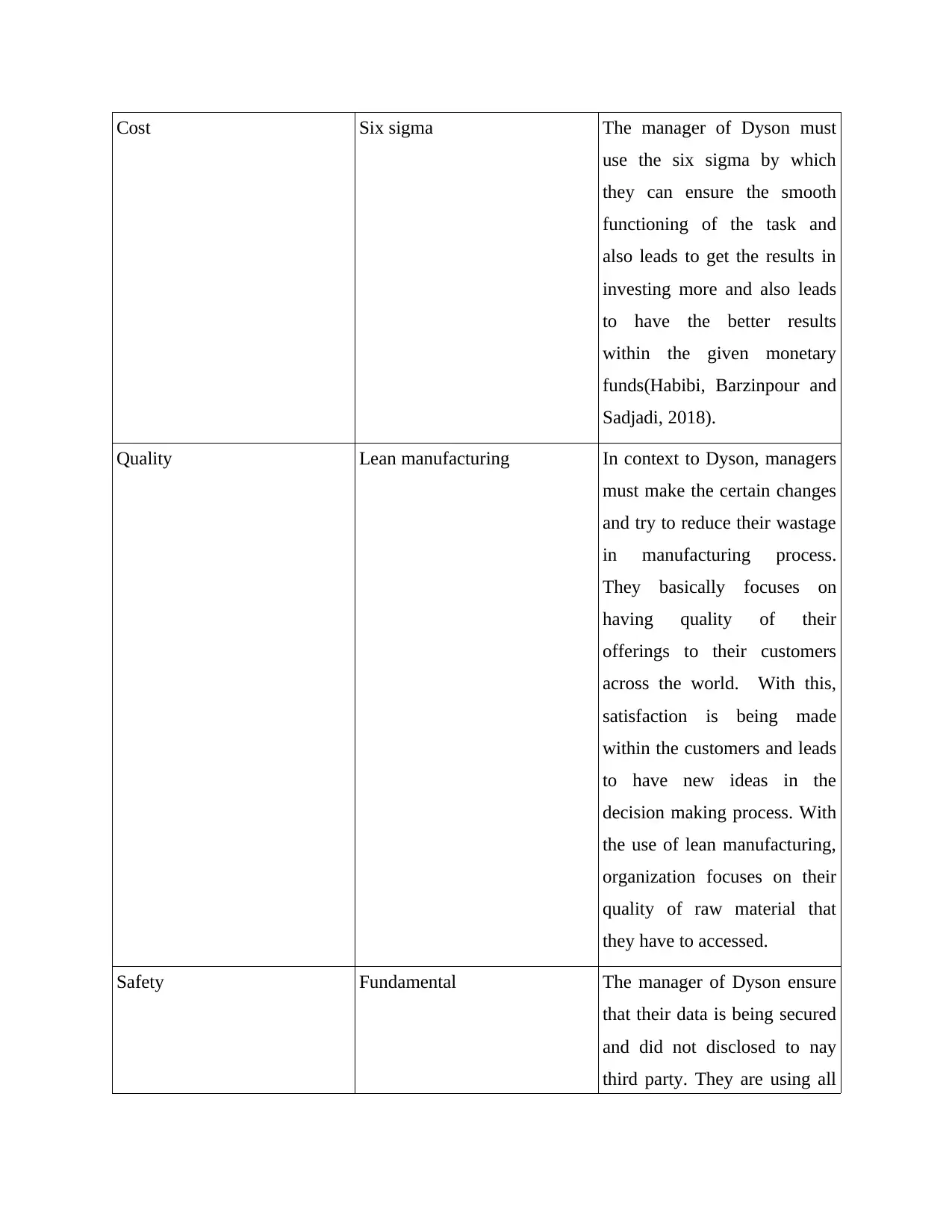
Cost Six sigma The manager of Dyson must
use the six sigma by which
they can ensure the smooth
functioning of the task and
also leads to get the results in
investing more and also leads
to have the better results
within the given monetary
funds(Habibi, Barzinpour and
Sadjadi, 2018).
Quality Lean manufacturing In context to Dyson, managers
must make the certain changes
and try to reduce their wastage
in manufacturing process.
They basically focuses on
having quality of their
offerings to their customers
across the world. With this,
satisfaction is being made
within the customers and leads
to have new ideas in the
decision making process. With
the use of lean manufacturing,
organization focuses on their
quality of raw material that
they have to accessed.
Safety Fundamental The manager of Dyson ensure
that their data is being secured
and did not disclosed to nay
third party. They are using all
use the six sigma by which
they can ensure the smooth
functioning of the task and
also leads to get the results in
investing more and also leads
to have the better results
within the given monetary
funds(Habibi, Barzinpour and
Sadjadi, 2018).
Quality Lean manufacturing In context to Dyson, managers
must make the certain changes
and try to reduce their wastage
in manufacturing process.
They basically focuses on
having quality of their
offerings to their customers
across the world. With this,
satisfaction is being made
within the customers and leads
to have new ideas in the
decision making process. With
the use of lean manufacturing,
organization focuses on their
quality of raw material that
they have to accessed.
Safety Fundamental The manager of Dyson ensure
that their data is being secured
and did not disclosed to nay
third party. They are using all
Secure Best Marks with AI Grader
Need help grading? Try our AI Grader for instant feedback on your assignments.

safety measure during the
manufacturing process.
Delivery Organisation Company ensures that they
must have the effective action
plan that are delivery methods
that includes the delivery of
products and equipments
which are being done
effectively. Moreover,
effective delivery of goods can
leads to reduce the wastage as
well.
It can be said from the above continuous improvement plan that the Dyson must made the
action plan and analyse the certain issues and difficulties which also leads to have the further
improvement in their quality and actions. They are using the lean manufacturing and six sigma
by which they can reduce the internal cost and time. This is the use of just-in-time inventory
principles which leads to reduce their cost of warehouse.
CONCLUSION
It is being concluded from the above report that the operations management is the process
of changing the raw material into finished commodities. Operation management process is being
done by the business and every business organisation is having their own operation management
process which leads to change the raw material into finished goods. Moreover, continuous
improvement plan is being made by the company for meeting their goals and objectives and have
developing their effectiveness as well.
PART 2
Project Title
In order to develop that focuses on offering the healthy food to staff by cooking food in-
house. The main objective of their project is to minimise the overall movement of staff from the
manufacturing process.
Delivery Organisation Company ensures that they
must have the effective action
plan that are delivery methods
that includes the delivery of
products and equipments
which are being done
effectively. Moreover,
effective delivery of goods can
leads to reduce the wastage as
well.
It can be said from the above continuous improvement plan that the Dyson must made the
action plan and analyse the certain issues and difficulties which also leads to have the further
improvement in their quality and actions. They are using the lean manufacturing and six sigma
by which they can reduce the internal cost and time. This is the use of just-in-time inventory
principles which leads to reduce their cost of warehouse.
CONCLUSION
It is being concluded from the above report that the operations management is the process
of changing the raw material into finished commodities. Operation management process is being
done by the business and every business organisation is having their own operation management
process which leads to change the raw material into finished goods. Moreover, continuous
improvement plan is being made by the company for meeting their goals and objectives and have
developing their effectiveness as well.
PART 2
Project Title
In order to develop that focuses on offering the healthy food to staff by cooking food in-
house. The main objective of their project is to minimise the overall movement of staff from the

office during the lunch break that is currently congestion issues in the local areas and also leads
to help the staff so that they can develop the healthy life and the company believe that, it is the
part of their CRS and also leads to reduce staff absenteeism.
An overview of the case study
The chosen business is Dyson, it is the multinational technology business which is being
established by James Dyson in 1991 at Malmesbury, England. This basically deals in designing
and manufacturing household appliances that are hand dryers, blade less fans, vacuum cleaners
and the hair dryers.
Explanation of each stage of the PLC
Project initiation, it is the first stage of project management life cycle that also states that the
plan the details of project which includes the business needs and the key participants &
stakeholders with the main scope of the given project and its related objectives that is followed
by the entire goal of the project. Furthermore, milestone and the budgets, roles & responsibilities,
measurement and success are being analyzed (Kerzner, 2018). With the given situation, the
objectives of the project is to offer the facility of the catering serveries to their employees which
help them to avoid to move out during their lunch break and can have the meal within the
premises. The main concern is to offer the food with safety and health of the workers. It is due
to, as it helps the corporate social responsibility of an organization and the workers satisfaction
within the enterprises. The scope of this project is to focuses the retention of the employees by
which an organization can ensures the better working of the employees as the talent employees
can take the company to the higher level of growth and success. Milestones of this respective
project will be each stage of life cycle in which progression is being measured with the
improvement and the changes. When taking the consideration of budget, it is being estimated the
initial budget for the first which is approx. 20Lakhs and due to the huge expenses of the kitchen,
transport, HR, permits and licenses. This budget can vary as per the choices of the people and
lower-down the resources of catering materials. Time estimation for completion can be five to
six months according to the number of employees within the company.
Project planning, this belong t the second stage of project management life cycle that states that
the details of scope planning & preparation of given task is being breakdown with the project
schedule development & resources planing that is being followed by the budget planning and the
allocation of resources with the proper risk management(Manikas and et. al., 2020).
to help the staff so that they can develop the healthy life and the company believe that, it is the
part of their CRS and also leads to reduce staff absenteeism.
An overview of the case study
The chosen business is Dyson, it is the multinational technology business which is being
established by James Dyson in 1991 at Malmesbury, England. This basically deals in designing
and manufacturing household appliances that are hand dryers, blade less fans, vacuum cleaners
and the hair dryers.
Explanation of each stage of the PLC
Project initiation, it is the first stage of project management life cycle that also states that the
plan the details of project which includes the business needs and the key participants &
stakeholders with the main scope of the given project and its related objectives that is followed
by the entire goal of the project. Furthermore, milestone and the budgets, roles & responsibilities,
measurement and success are being analyzed (Kerzner, 2018). With the given situation, the
objectives of the project is to offer the facility of the catering serveries to their employees which
help them to avoid to move out during their lunch break and can have the meal within the
premises. The main concern is to offer the food with safety and health of the workers. It is due
to, as it helps the corporate social responsibility of an organization and the workers satisfaction
within the enterprises. The scope of this project is to focuses the retention of the employees by
which an organization can ensures the better working of the employees as the talent employees
can take the company to the higher level of growth and success. Milestones of this respective
project will be each stage of life cycle in which progression is being measured with the
improvement and the changes. When taking the consideration of budget, it is being estimated the
initial budget for the first which is approx. 20Lakhs and due to the huge expenses of the kitchen,
transport, HR, permits and licenses. This budget can vary as per the choices of the people and
lower-down the resources of catering materials. Time estimation for completion can be five to
six months according to the number of employees within the company.
Project planning, this belong t the second stage of project management life cycle that states that
the details of scope planning & preparation of given task is being breakdown with the project
schedule development & resources planing that is being followed by the budget planning and the
allocation of resources with the proper risk management(Manikas and et. al., 2020).
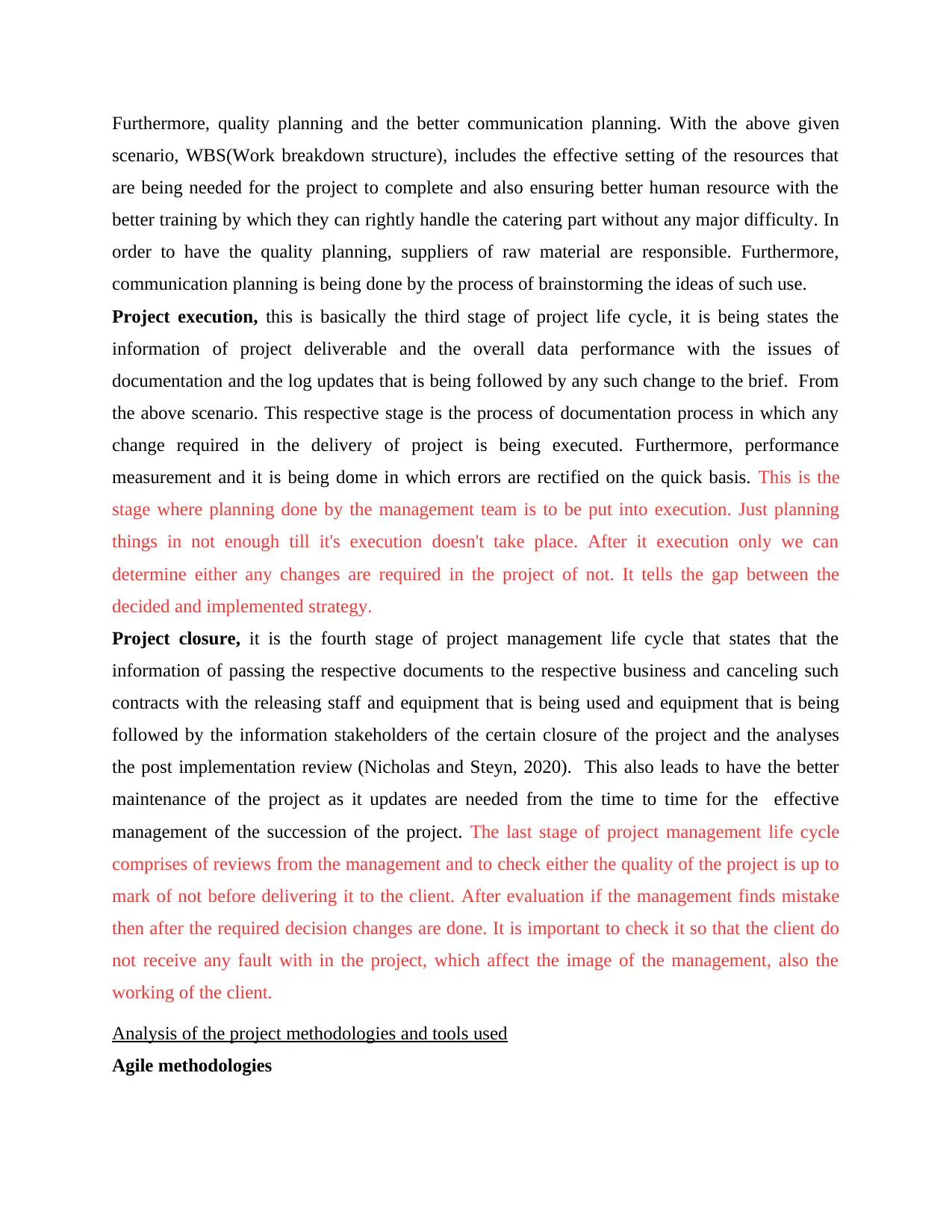
Furthermore, quality planning and the better communication planning. With the above given
scenario, WBS(Work breakdown structure), includes the effective setting of the resources that
are being needed for the project to complete and also ensuring better human resource with the
better training by which they can rightly handle the catering part without any major difficulty. In
order to have the quality planning, suppliers of raw material are responsible. Furthermore,
communication planning is being done by the process of brainstorming the ideas of such use.
Project execution, this is basically the third stage of project life cycle, it is being states the
information of project deliverable and the overall data performance with the issues of
documentation and the log updates that is being followed by any such change to the brief. From
the above scenario. This respective stage is the process of documentation process in which any
change required in the delivery of project is being executed. Furthermore, performance
measurement and it is being dome in which errors are rectified on the quick basis. This is the
stage where planning done by the management team is to be put into execution. Just planning
things in not enough till it's execution doesn't take place. After it execution only we can
determine either any changes are required in the project of not. It tells the gap between the
decided and implemented strategy.
Project closure, it is the fourth stage of project management life cycle that states that the
information of passing the respective documents to the respective business and canceling such
contracts with the releasing staff and equipment that is being used and equipment that is being
followed by the information stakeholders of the certain closure of the project and the analyses
the post implementation review (Nicholas and Steyn, 2020). This also leads to have the better
maintenance of the project as it updates are needed from the time to time for the effective
management of the succession of the project. The last stage of project management life cycle
comprises of reviews from the management and to check either the quality of the project is up to
mark of not before delivering it to the client. After evaluation if the management finds mistake
then after the required decision changes are done. It is important to check it so that the client do
not receive any fault with in the project, which affect the image of the management, also the
working of the client.
Analysis of the project methodologies and tools used
Agile methodologies
scenario, WBS(Work breakdown structure), includes the effective setting of the resources that
are being needed for the project to complete and also ensuring better human resource with the
better training by which they can rightly handle the catering part without any major difficulty. In
order to have the quality planning, suppliers of raw material are responsible. Furthermore,
communication planning is being done by the process of brainstorming the ideas of such use.
Project execution, this is basically the third stage of project life cycle, it is being states the
information of project deliverable and the overall data performance with the issues of
documentation and the log updates that is being followed by any such change to the brief. From
the above scenario. This respective stage is the process of documentation process in which any
change required in the delivery of project is being executed. Furthermore, performance
measurement and it is being dome in which errors are rectified on the quick basis. This is the
stage where planning done by the management team is to be put into execution. Just planning
things in not enough till it's execution doesn't take place. After it execution only we can
determine either any changes are required in the project of not. It tells the gap between the
decided and implemented strategy.
Project closure, it is the fourth stage of project management life cycle that states that the
information of passing the respective documents to the respective business and canceling such
contracts with the releasing staff and equipment that is being used and equipment that is being
followed by the information stakeholders of the certain closure of the project and the analyses
the post implementation review (Nicholas and Steyn, 2020). This also leads to have the better
maintenance of the project as it updates are needed from the time to time for the effective
management of the succession of the project. The last stage of project management life cycle
comprises of reviews from the management and to check either the quality of the project is up to
mark of not before delivering it to the client. After evaluation if the management finds mistake
then after the required decision changes are done. It is important to check it so that the client do
not receive any fault with in the project, which affect the image of the management, also the
working of the client.
Analysis of the project methodologies and tools used
Agile methodologies
Paraphrase This Document
Need a fresh take? Get an instant paraphrase of this document with our AI Paraphraser
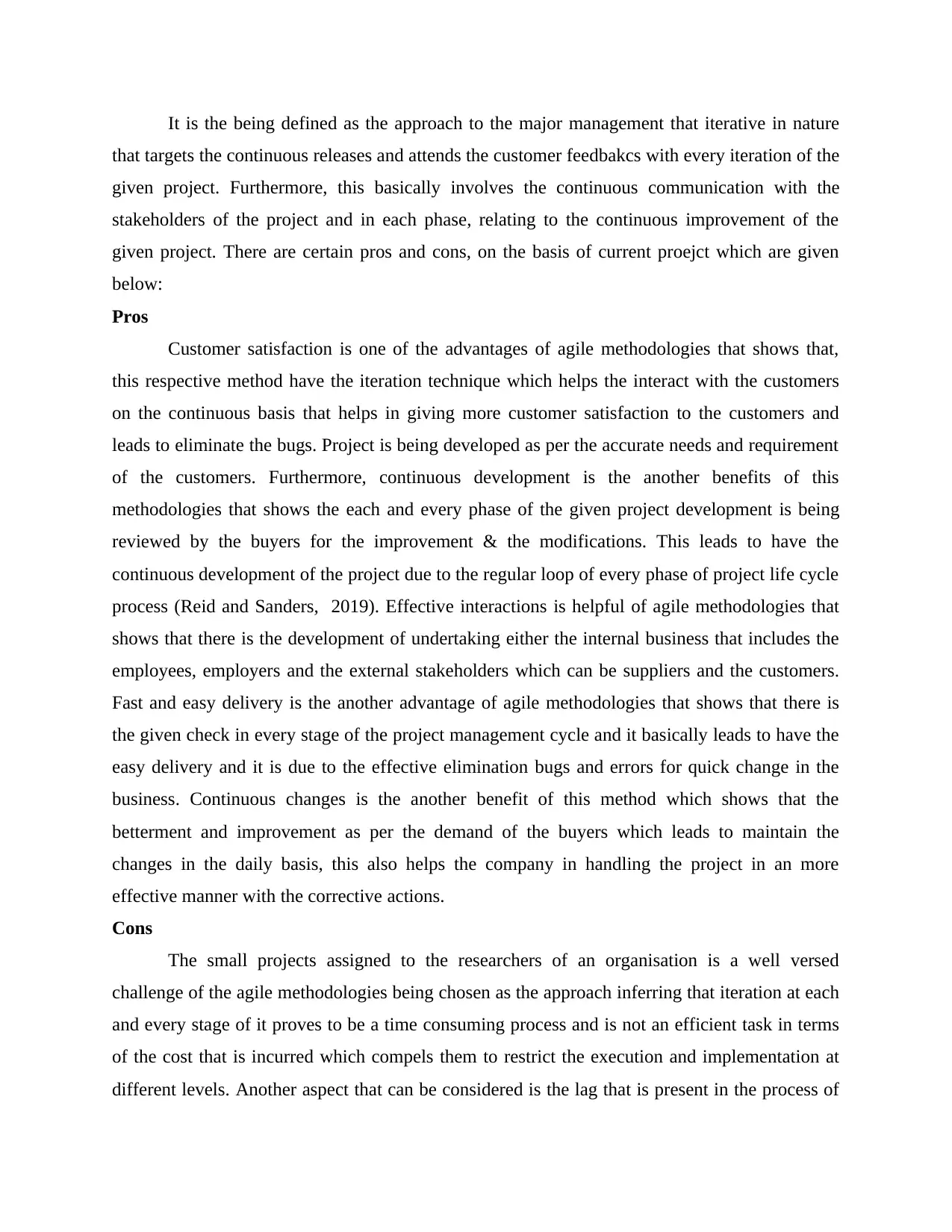
It is the being defined as the approach to the major management that iterative in nature
that targets the continuous releases and attends the customer feedbakcs with every iteration of the
given project. Furthermore, this basically involves the continuous communication with the
stakeholders of the project and in each phase, relating to the continuous improvement of the
given project. There are certain pros and cons, on the basis of current proejct which are given
below:
Pros
Customer satisfaction is one of the advantages of agile methodologies that shows that,
this respective method have the iteration technique which helps the interact with the customers
on the continuous basis that helps in giving more customer satisfaction to the customers and
leads to eliminate the bugs. Project is being developed as per the accurate needs and requirement
of the customers. Furthermore, continuous development is the another benefits of this
methodologies that shows the each and every phase of the given project development is being
reviewed by the buyers for the improvement & the modifications. This leads to have the
continuous development of the project due to the regular loop of every phase of project life cycle
process (Reid and Sanders, 2019). Effective interactions is helpful of agile methodologies that
shows that there is the development of undertaking either the internal business that includes the
employees, employers and the external stakeholders which can be suppliers and the customers.
Fast and easy delivery is the another advantage of agile methodologies that shows that there is
the given check in every stage of the project management cycle and it basically leads to have the
easy delivery and it is due to the effective elimination bugs and errors for quick change in the
business. Continuous changes is the another benefit of this method which shows that the
betterment and improvement as per the demand of the buyers which leads to maintain the
changes in the daily basis, this also helps the company in handling the project in an more
effective manner with the corrective actions.
Cons
The small projects assigned to the researchers of an organisation is a well versed
challenge of the agile methodologies being chosen as the approach inferring that iteration at each
and every stage of it proves to be a time consuming process and is not an efficient task in terms
of the cost that is incurred which compels them to restrict the execution and implementation at
different levels. Another aspect that can be considered is the lag that is present in the process of
that targets the continuous releases and attends the customer feedbakcs with every iteration of the
given project. Furthermore, this basically involves the continuous communication with the
stakeholders of the project and in each phase, relating to the continuous improvement of the
given project. There are certain pros and cons, on the basis of current proejct which are given
below:
Pros
Customer satisfaction is one of the advantages of agile methodologies that shows that,
this respective method have the iteration technique which helps the interact with the customers
on the continuous basis that helps in giving more customer satisfaction to the customers and
leads to eliminate the bugs. Project is being developed as per the accurate needs and requirement
of the customers. Furthermore, continuous development is the another benefits of this
methodologies that shows the each and every phase of the given project development is being
reviewed by the buyers for the improvement & the modifications. This leads to have the
continuous development of the project due to the regular loop of every phase of project life cycle
process (Reid and Sanders, 2019). Effective interactions is helpful of agile methodologies that
shows that there is the development of undertaking either the internal business that includes the
employees, employers and the external stakeholders which can be suppliers and the customers.
Fast and easy delivery is the another advantage of agile methodologies that shows that there is
the given check in every stage of the project management cycle and it basically leads to have the
easy delivery and it is due to the effective elimination bugs and errors for quick change in the
business. Continuous changes is the another benefit of this method which shows that the
betterment and improvement as per the demand of the buyers which leads to maintain the
changes in the daily basis, this also helps the company in handling the project in an more
effective manner with the corrective actions.
Cons
The small projects assigned to the researchers of an organisation is a well versed
challenge of the agile methodologies being chosen as the approach inferring that iteration at each
and every stage of it proves to be a time consuming process and is not an efficient task in terms
of the cost that is incurred which compels them to restrict the execution and implementation at
different levels. Another aspect that can be considered is the lag that is present in the process of
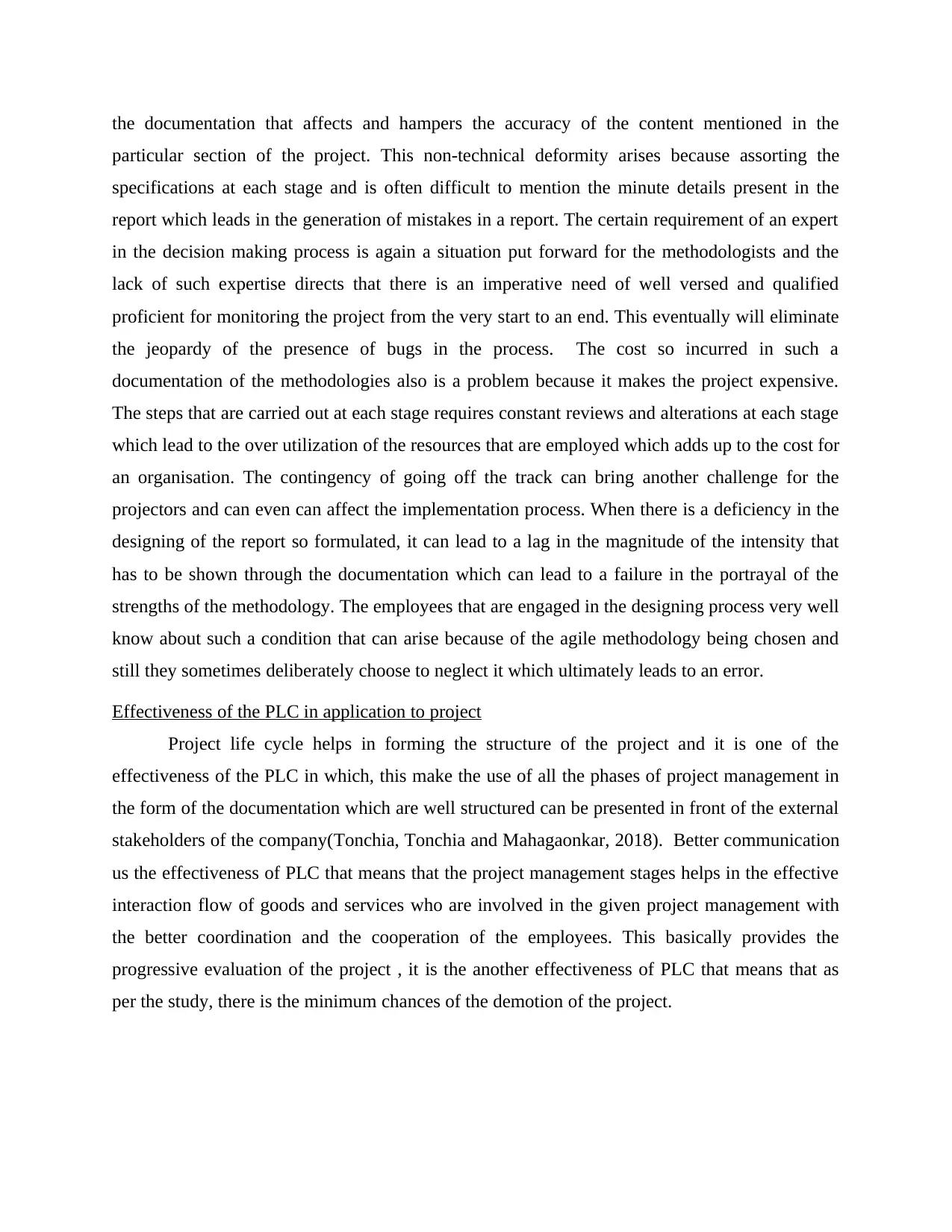
the documentation that affects and hampers the accuracy of the content mentioned in the
particular section of the project. This non-technical deformity arises because assorting the
specifications at each stage and is often difficult to mention the minute details present in the
report which leads in the generation of mistakes in a report. The certain requirement of an expert
in the decision making process is again a situation put forward for the methodologists and the
lack of such expertise directs that there is an imperative need of well versed and qualified
proficient for monitoring the project from the very start to an end. This eventually will eliminate
the jeopardy of the presence of bugs in the process. The cost so incurred in such a
documentation of the methodologies also is a problem because it makes the project expensive.
The steps that are carried out at each stage requires constant reviews and alterations at each stage
which lead to the over utilization of the resources that are employed which adds up to the cost for
an organisation. The contingency of going off the track can bring another challenge for the
projectors and can even can affect the implementation process. When there is a deficiency in the
designing of the report so formulated, it can lead to a lag in the magnitude of the intensity that
has to be shown through the documentation which can lead to a failure in the portrayal of the
strengths of the methodology. The employees that are engaged in the designing process very well
know about such a condition that can arise because of the agile methodology being chosen and
still they sometimes deliberately choose to neglect it which ultimately leads to an error.
Effectiveness of the PLC in application to project
Project life cycle helps in forming the structure of the project and it is one of the
effectiveness of the PLC in which, this make the use of all the phases of project management in
the form of the documentation which are well structured can be presented in front of the external
stakeholders of the company(Tonchia, Tonchia and Mahagaonkar, 2018). Better communication
us the effectiveness of PLC that means that the project management stages helps in the effective
interaction flow of goods and services who are involved in the given project management with
the better coordination and the cooperation of the employees. This basically provides the
progressive evaluation of the project , it is the another effectiveness of PLC that means that as
per the study, there is the minimum chances of the demotion of the project.
particular section of the project. This non-technical deformity arises because assorting the
specifications at each stage and is often difficult to mention the minute details present in the
report which leads in the generation of mistakes in a report. The certain requirement of an expert
in the decision making process is again a situation put forward for the methodologists and the
lack of such expertise directs that there is an imperative need of well versed and qualified
proficient for monitoring the project from the very start to an end. This eventually will eliminate
the jeopardy of the presence of bugs in the process. The cost so incurred in such a
documentation of the methodologies also is a problem because it makes the project expensive.
The steps that are carried out at each stage requires constant reviews and alterations at each stage
which lead to the over utilization of the resources that are employed which adds up to the cost for
an organisation. The contingency of going off the track can bring another challenge for the
projectors and can even can affect the implementation process. When there is a deficiency in the
designing of the report so formulated, it can lead to a lag in the magnitude of the intensity that
has to be shown through the documentation which can lead to a failure in the portrayal of the
strengths of the methodology. The employees that are engaged in the designing process very well
know about such a condition that can arise because of the agile methodology being chosen and
still they sometimes deliberately choose to neglect it which ultimately leads to an error.
Effectiveness of the PLC in application to project
Project life cycle helps in forming the structure of the project and it is one of the
effectiveness of the PLC in which, this make the use of all the phases of project management in
the form of the documentation which are well structured can be presented in front of the external
stakeholders of the company(Tonchia, Tonchia and Mahagaonkar, 2018). Better communication
us the effectiveness of PLC that means that the project management stages helps in the effective
interaction flow of goods and services who are involved in the given project management with
the better coordination and the cooperation of the employees. This basically provides the
progressive evaluation of the project , it is the another effectiveness of PLC that means that as
per the study, there is the minimum chances of the demotion of the project.
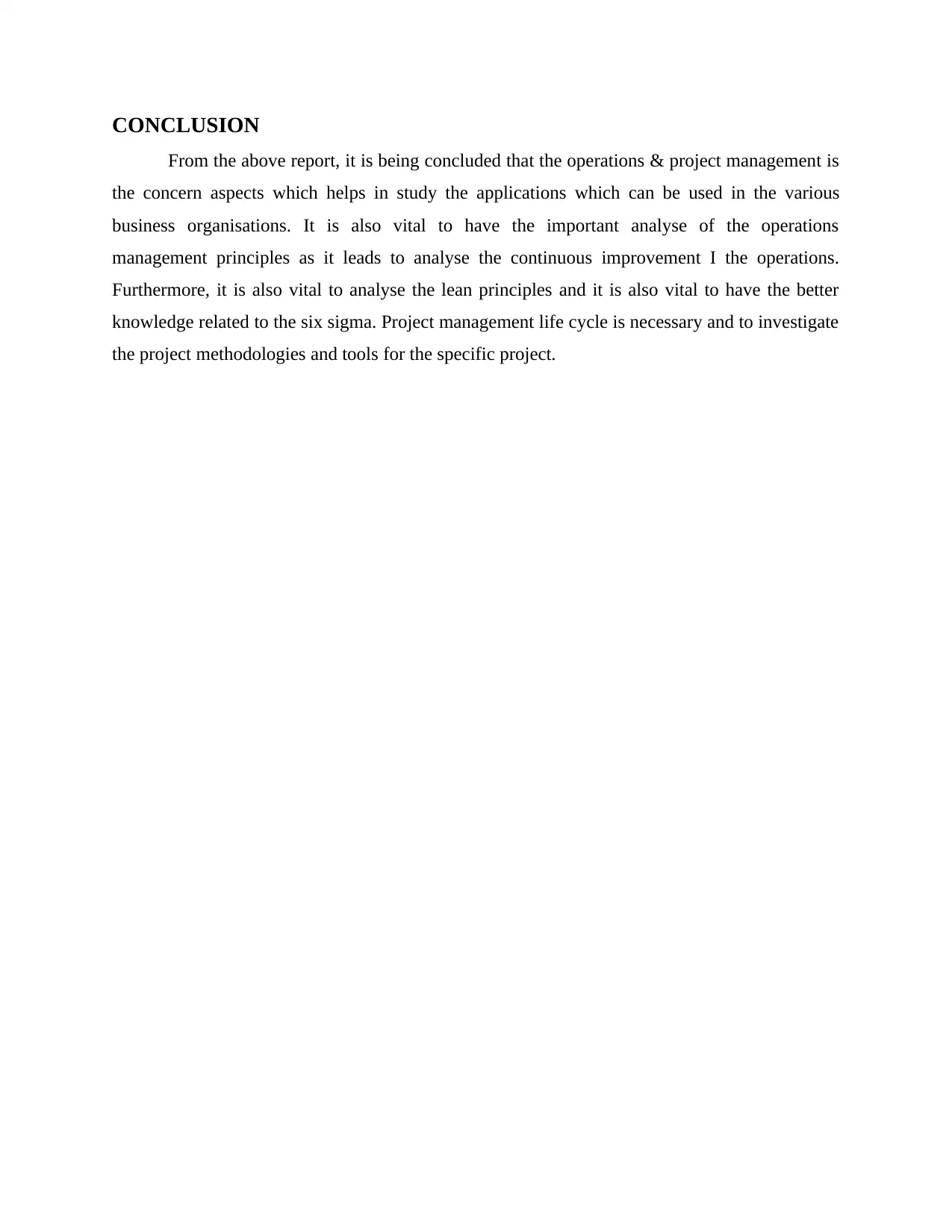
CONCLUSION
From the above report, it is being concluded that the operations & project management is
the concern aspects which helps in study the applications which can be used in the various
business organisations. It is also vital to have the important analyse of the operations
management principles as it leads to analyse the continuous improvement I the operations.
Furthermore, it is also vital to analyse the lean principles and it is also vital to have the better
knowledge related to the six sigma. Project management life cycle is necessary and to investigate
the project methodologies and tools for the specific project.
From the above report, it is being concluded that the operations & project management is
the concern aspects which helps in study the applications which can be used in the various
business organisations. It is also vital to have the important analyse of the operations
management principles as it leads to analyse the continuous improvement I the operations.
Furthermore, it is also vital to analyse the lean principles and it is also vital to have the better
knowledge related to the six sigma. Project management life cycle is necessary and to investigate
the project methodologies and tools for the specific project.
Secure Best Marks with AI Grader
Need help grading? Try our AI Grader for instant feedback on your assignments.
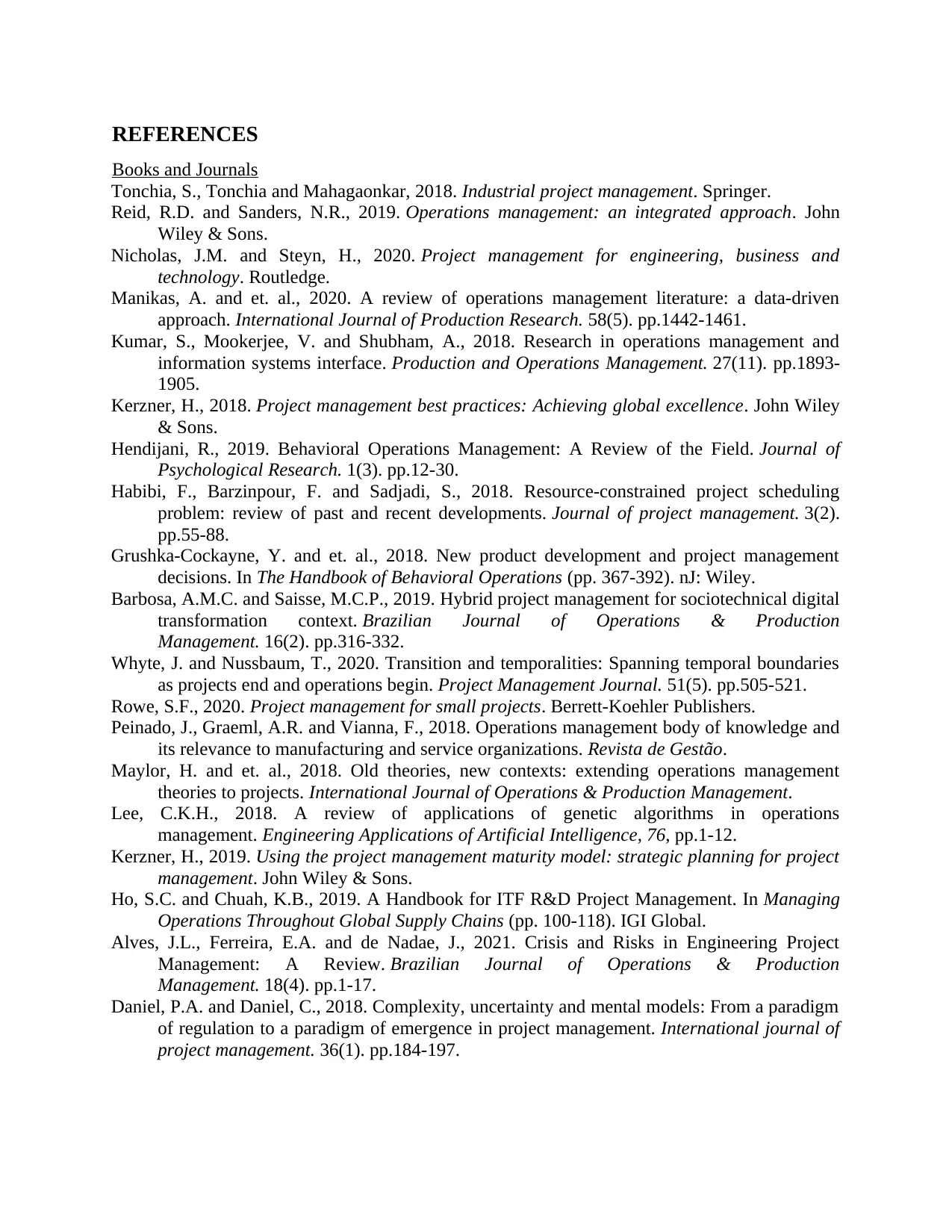
REFERENCES
Books and Journals
Tonchia, S., Tonchia and Mahagaonkar, 2018. Industrial project management. Springer.
Reid, R.D. and Sanders, N.R., 2019. Operations management: an integrated approach. John
Wiley & Sons.
Nicholas, J.M. and Steyn, H., 2020. Project management for engineering, business and
technology. Routledge.
Manikas, A. and et. al., 2020. A review of operations management literature: a data-driven
approach. International Journal of Production Research. 58(5). pp.1442-1461.
Kumar, S., Mookerjee, V. and Shubham, A., 2018. Research in operations management and
information systems interface. Production and Operations Management. 27(11). pp.1893-
1905.
Kerzner, H., 2018. Project management best practices: Achieving global excellence. John Wiley
& Sons.
Hendijani, R., 2019. Behavioral Operations Management: A Review of the Field. Journal of
Psychological Research. 1(3). pp.12-30.
Habibi, F., Barzinpour, F. and Sadjadi, S., 2018. Resource-constrained project scheduling
problem: review of past and recent developments. Journal of project management. 3(2).
pp.55-88.
Grushka-Cockayne, Y. and et. al., 2018. New product development and project management
decisions. In The Handbook of Behavioral Operations (pp. 367-392). nJ: Wiley.
Barbosa, A.M.C. and Saisse, M.C.P., 2019. Hybrid project management for sociotechnical digital
transformation context. Brazilian Journal of Operations & Production
Management. 16(2). pp.316-332.
Whyte, J. and Nussbaum, T., 2020. Transition and temporalities: Spanning temporal boundaries
as projects end and operations begin. Project Management Journal. 51(5). pp.505-521.
Rowe, S.F., 2020. Project management for small projects. Berrett-Koehler Publishers.
Peinado, J., Graeml, A.R. and Vianna, F., 2018. Operations management body of knowledge and
its relevance to manufacturing and service organizations. Revista de Gestão.
Maylor, H. and et. al., 2018. Old theories, new contexts: extending operations management
theories to projects. International Journal of Operations & Production Management.
Lee, C.K.H., 2018. A review of applications of genetic algorithms in operations
management. Engineering Applications of Artificial Intelligence, 76, pp.1-12.
Kerzner, H., 2019. Using the project management maturity model: strategic planning for project
management. John Wiley & Sons.
Ho, S.C. and Chuah, K.B., 2019. A Handbook for ITF R&D Project Management. In Managing
Operations Throughout Global Supply Chains (pp. 100-118). IGI Global.
Alves, J.L., Ferreira, E.A. and de Nadae, J., 2021. Crisis and Risks in Engineering Project
Management: A Review. Brazilian Journal of Operations & Production
Management. 18(4). pp.1-17.
Daniel, P.A. and Daniel, C., 2018. Complexity, uncertainty and mental models: From a paradigm
of regulation to a paradigm of emergence in project management. International journal of
project management. 36(1). pp.184-197.
Books and Journals
Tonchia, S., Tonchia and Mahagaonkar, 2018. Industrial project management. Springer.
Reid, R.D. and Sanders, N.R., 2019. Operations management: an integrated approach. John
Wiley & Sons.
Nicholas, J.M. and Steyn, H., 2020. Project management for engineering, business and
technology. Routledge.
Manikas, A. and et. al., 2020. A review of operations management literature: a data-driven
approach. International Journal of Production Research. 58(5). pp.1442-1461.
Kumar, S., Mookerjee, V. and Shubham, A., 2018. Research in operations management and
information systems interface. Production and Operations Management. 27(11). pp.1893-
1905.
Kerzner, H., 2018. Project management best practices: Achieving global excellence. John Wiley
& Sons.
Hendijani, R., 2019. Behavioral Operations Management: A Review of the Field. Journal of
Psychological Research. 1(3). pp.12-30.
Habibi, F., Barzinpour, F. and Sadjadi, S., 2018. Resource-constrained project scheduling
problem: review of past and recent developments. Journal of project management. 3(2).
pp.55-88.
Grushka-Cockayne, Y. and et. al., 2018. New product development and project management
decisions. In The Handbook of Behavioral Operations (pp. 367-392). nJ: Wiley.
Barbosa, A.M.C. and Saisse, M.C.P., 2019. Hybrid project management for sociotechnical digital
transformation context. Brazilian Journal of Operations & Production
Management. 16(2). pp.316-332.
Whyte, J. and Nussbaum, T., 2020. Transition and temporalities: Spanning temporal boundaries
as projects end and operations begin. Project Management Journal. 51(5). pp.505-521.
Rowe, S.F., 2020. Project management for small projects. Berrett-Koehler Publishers.
Peinado, J., Graeml, A.R. and Vianna, F., 2018. Operations management body of knowledge and
its relevance to manufacturing and service organizations. Revista de Gestão.
Maylor, H. and et. al., 2018. Old theories, new contexts: extending operations management
theories to projects. International Journal of Operations & Production Management.
Lee, C.K.H., 2018. A review of applications of genetic algorithms in operations
management. Engineering Applications of Artificial Intelligence, 76, pp.1-12.
Kerzner, H., 2019. Using the project management maturity model: strategic planning for project
management. John Wiley & Sons.
Ho, S.C. and Chuah, K.B., 2019. A Handbook for ITF R&D Project Management. In Managing
Operations Throughout Global Supply Chains (pp. 100-118). IGI Global.
Alves, J.L., Ferreira, E.A. and de Nadae, J., 2021. Crisis and Risks in Engineering Project
Management: A Review. Brazilian Journal of Operations & Production
Management. 18(4). pp.1-17.
Daniel, P.A. and Daniel, C., 2018. Complexity, uncertainty and mental models: From a paradigm
of regulation to a paradigm of emergence in project management. International journal of
project management. 36(1). pp.184-197.
1 out of 17
Related Documents
Your All-in-One AI-Powered Toolkit for Academic Success.
+13062052269
info@desklib.com
Available 24*7 on WhatsApp / Email
![[object Object]](/_next/static/media/star-bottom.7253800d.svg)
Unlock your academic potential
© 2024 | Zucol Services PVT LTD | All rights reserved.


